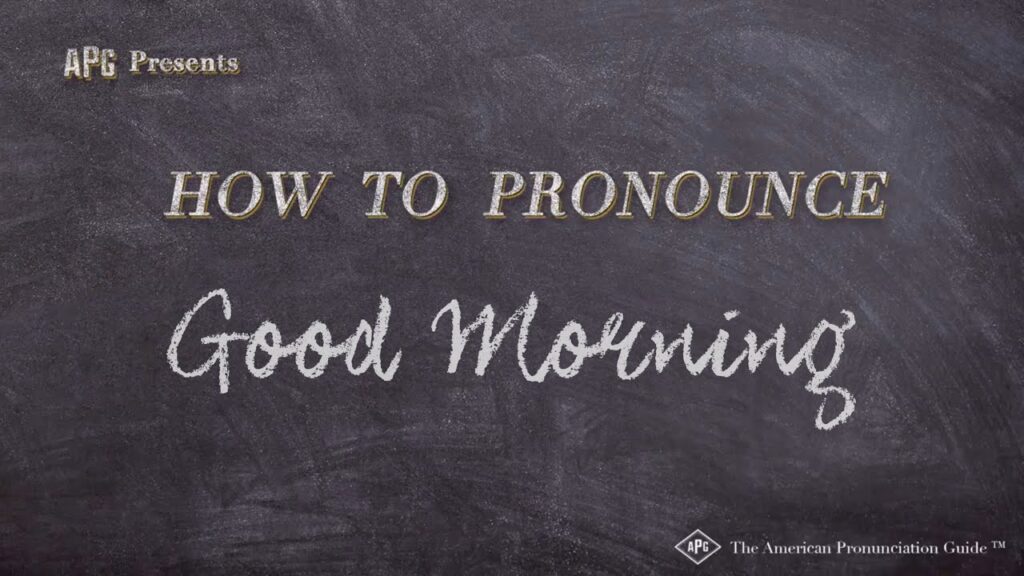How to Pronounce “Good Morning”: A Comprehensive Guide
“Good morning” is a common greeting used to acknowledge someone in the morning hours. Correct pronunciation is essential for effective communication, especially for language learners and those looking to improve their English speaking skills. This article will provide an in-depth exploration of how to pronounce “good morning,” including phonetic breakdowns, audio examples, cultural significance, and practical tips for mastering this phrase.
Understanding the Phrase “Good Morning”
The phrase “good morning” consists of two words: “good” and “morning.” Each word has its own pronunciation, and when combined, they create a common salutation used primarily in English-speaking countries.
Breakdown of the Phrase
- Good: This word is an adjective that expresses a positive quality or state.
- Morning: This noun refers to the early part of the day, typically from sunrise until noon.
Phonetic Pronunciation
The pronunciation of “good morning” can vary slightly between British and American English. Here’s a phonetic breakdown:
| Accent | Phonetic Spelling | IPA Notation |
|---|---|---|
| American | gud MOR-ning | /ɡʊd ˈmɔrnɪŋ/ |
| British | gud MORN-ing | /ɡʊd ˈmɔːnɪŋ/ |
Audio Examples
To hear the pronunciation, you can refer to resources like the Cambridge Dictionary, which provides audio examples of both American and British pronunciations.
Syllable Stress
When pronouncing “good morning,” the stress is typically placed on the second syllable of “morning.” This means that when you say the phrase, it should sound like: good MOR-ning.
Importance of Pronunciation
Accurate pronunciation is crucial for effective communication. Mispronouncing common phrases can lead to misunderstandings or make it difficult for others to understand you. Here are some reasons why mastering the pronunciation of “good morning” is beneficial:
- First Impressions: Greeting someone correctly can create a positive first impression.
- Cultural Significance: In many cultures, greetings are an important part of social interaction. Proper pronunciation shows respect for the language and culture.
- Building Confidence: Mastering common phrases boosts confidence in speaking and encourages further language practice.
Tips for Pronouncing “Good Morning”
Here are some practical tips to help you pronounce “good morning” correctly:
- Practice Phonetics: Familiarize yourself with the phonetic sounds of each word. Focus on the vowel sounds and how they differ between accents.
- Listen and Repeat: Use online resources or language apps to listen to native speakers pronounce “good morning.” Repeat after them to practice your pronunciation.
- Record Yourself: Record your pronunciation and listen to it. Compare it to native speakers to identify areas for improvement.
- Focus on Syllable Stress: Emphasize the second syllable in “morning.” Practicing this can help make your pronunciation sound more natural.
- Use in Context: Practice using the phrase in conversations. The more you use it, the more comfortable you will become with its pronunciation.
Cultural Context of “Good Morning”
The phrase “good morning” is used in various English-speaking cultures as a polite way to greet someone during the morning hours. Its usage can vary depending on the context:
- Formal Settings: In professional or formal settings, using “good morning” is a standard greeting when meeting colleagues or clients.
- Informal Settings: Among friends and family, “good morning” is often used casually, sometimes accompanied by a smile or a wave.
- Cultural Variations: While “good morning” is widely used in English-speaking countries, other languages have their own equivalents. For example:
- Spanish: “Buenos días”
- French: “Bonjour”
- German: “Guten Morgen”
Common Mistakes in Pronunciation
When learning to pronounce “good morning,” learners may encounter several common mistakes:
- Overemphasizing the First Syllable: Some learners may place too much emphasis on “good,” making it sound like “GOOd morning.” Instead, focus on the stress in “morning.”
- Mispronouncing Vowel Sounds: The vowel sounds in “good” and “morning” can be tricky. Ensure you pronounce “good” with a short “u” sound and “morning” with the correct vowel sound for “or.”
- Rushing the Phrase: In an attempt to speak quickly, learners may slur the words together. Practice saying the phrase slowly and clearly before gradually increasing your speed.
Frequently Asked Questions (FAQs)
1. How do you pronounce “good morning”?
“Good morning” is pronounced as /ɡʊd ˈmɔrnɪŋ/ in American English and /ɡʊd ˈmɔːnɪŋ/ in British English.
2. What is the correct syllable stress in “good morning”?
The stress is on the second syllable of “morning,” making it sound like “good MOR-ning.”
3. Why is pronunciation important?
Proper pronunciation is important for clear communication, making a good impression, and showing respect for the language.
4. How can I improve my pronunciation of “good morning”?
Practice phonetics, listen to native speakers, record yourself, and use the phrase in context to improve your pronunciation.
5. Are there cultural differences in using “good morning”?
Yes, while “good morning” is common in English-speaking cultures, other languages have their own greetings for the morning.
Conclusion
Mastering the pronunciation of “good morning” is an essential skill for effective communication in English. By understanding the phonetic breakdown, practicing regularly, and being aware of cultural contexts, you can confidently greet others in the morning. Whether in a formal setting or casual conversation, saying “good morning” correctly can enhance your interactions and foster positive relationships.
Additional Resources
For more information on pronunciation, you can refer to the following link:
- Wikipedia – Pronunciation
This comprehensive guide provides insights into the pronunciation of “good morning,” ensuring that you can greet others confidently and clearly.



